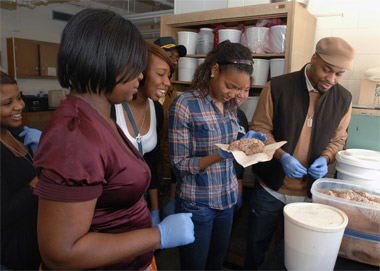
Brainiacs -- Under the watchful eye of SIUC medical student Safiya D. McNeese (foreground), Ashley A. Ahart, a senior from Trinity Christian School, probes the mystery of a brain while other students eagerly wait their turn. (Photo by Russell D. Bailey) Download Photo Here
April 27, 2010
Program benefits high school, SIUC students
CARBONDALE, Ill. -- They really wanted to see the bodies, but handling the brain was almost as good.
“I thought it would be soft and somewhat squishy, but it was hard, and it smelled like the sore throat medicine Chloraseptic,” said Darlene Sao, a junior at Carbondale Community High School, after touring the cadaver lab at Southern Illinois University Carbondale.
“It was pretty cool knowing that I was holding an organ that at one time had controlled functions in the body.”
Sao was one of 14 area high-schoolers who took part in a four-day program near the end of March aimed at introducing them to college life and career choices. Matched with SIUC graduate and undergraduate mentors, the students sat in on classes, listened to presentations, toured the campus, saw some residence halls and got a taste of university cooking.
Their visit came about as part of Assistant Professor Cynthia H. Sims’ efforts to foster the leadership skills of her own students in workforce education and development.
“Research suggests that many college graduates are proficient in technology but lack the requisite ‘soft skills’ to make them effective employees and managers,” Sims said.
“My graduate students were responsible for recruiting and training the mentors and developing the program, and they had to make sure it wasn’t just about the high school students -- the mentors had to get something out of it, too. If you’re a mentor, for example, and giving a talk or a tour, you’re developing your oral presentation skills.”
Sims, whose research focus includes minorities in higher education, also had a particular interest in bringing in high schoolers who would enhance the diversity of whatever universities they attend. Most who took part in this project came from minority backgrounds, and one-third of them were enrolled in G.E.D. programs.
“As the country’s diversity increases, workplaces also will become more diverse,” Sims said. “College campuses must become the ‘lab’ where future workers can learn to appreciate the diverse backgrounds of others as well as practice working with those who are different from themselves. Diversity enriches both the college campus and the workplace, so we must prepare our future leaders to view diversity as an asset.”
Safiya D. McNeese, now a first-year medical student, took part in an earlier, more extended version of Sims’ mentorship program in 2007 while enrolled in SIUC’s MEDPREP, which helps disadvantaged students prepare for careers in medicine and dentistry. She was keen on being asked again.
“For impressionable youth, it is necessary to have positive influences to counteract the many negative influences regarding what’s important and the paths to take in life,” said McNeese, a single mother of two and U.S. Navy officer who plans on becoming a Navy physician. “This program provides that.”
McNeese, who also has experience in social work, said her group, which included students interested in nursing, medicine, social work and the military, seemed handpicked just for her.
“I could share and connect with each one of them on their level and at their interest,” she said. ”It’s particularly meaningful when they light up and become excited about the experience, when they seem genuinely interested and want to learn more.”
It was McNeese who took her mentees through the cadaver lab. Though disappointed that the rules prevented them from viewing the bodies in the closed metal cases, the students perked up when offered the chance to get up-close and personal with some hearts and brains, crowding round McNeese for the sets of blue latex gloves they would need when handling body parts. The room grew quiet as she carefully withdrew a heart from a jar of preservative and set it gently in a pair of gloved hands. There was a moment of silence, then a softly murmured, “Wow.”
Sims said, “I was especially pleased with the cadaver lab experience. I would have liked for all the students throughout the week to have seen that -- it was the best hands-on experience.”
Thirteen of the 14 high school students taking part in the program turned in evaluations, and nearly all of them rated the experience a “10.” They said such things as, “I liked it a lot. I learned a lot of stuff I didn’t know,” and “It was an awesome experience. Gave me a lot of valuable information,” and “It gave me an extra shove to want to experience more and learn new things.”
But it also convinced them to take a closer look at SIUC. “It made me realize how fun and exciting SIU is,” wrote one. “This made me realize how nice a campus SIUC provides -- I am now considering it more seriously than I was before,” wrote another. “It’s now one of my top options for college,” wrote a third.
Sims was pleased. “My overall goal is for students to go to college -- any college -- but if this works as a recruitment tool, that’s OK, too,” she said with a smile.
